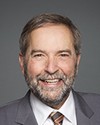Thank you, Mr. Chairman.
It is always a pleasure having the Governor of the Bank of Canada here, a person who, in my view, has greatly contributed to maintaining stability through what has been one of the biggest crises in the history of our country.
I am going to ask some technical questions, but also some about the institution. It will come as no surprise to Mr. Carney that I would like to discuss the appointment of Mr. Hodgson. I had occasion to comment publicly on that over the summer.
I would like to begin by saying that when you appoint an individual, you have to make sure that people do not think the individual is under any accusations. Mr. Hodgson has an extraordinary track record, just like Mr. Carney, in point of fact. The fact that he worked for Goldman Sachs does not make him damaged goods that have to be rejected. The question is how can you appoint Mr. Hodgson, who was chief executive officer at Goldman Sachs Canada, and give him a key role in developing our reforms, when he says from the outset that he will only be there for an 18-month term.
This issue of revolving doors is of concern to all parliamentarians. There are some very strict rules that apply to us and our staff, as well as parliamentary secretaries and ministers, especially. So we see a problem with this situation, a problem of perception, of course, but there could also be an underlying problem.
I would ask Mr. Carney to explain to us how he can accept this appointment for such a short time—18 months in the life of an institution like the Bank of Canada is very short—and allow Mr. Hodgson to return to the private sector after gaining in-depth knowledge of all of the internal aspects of the architecture and projects of the Bank of Canada. I have to admit that the situation raises substantive issues in my mind about the stewardship of our institutions.

